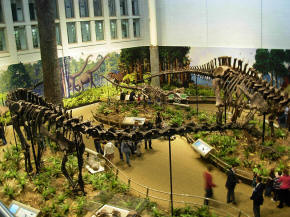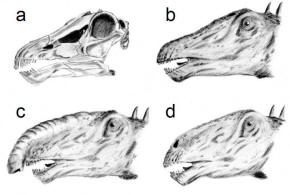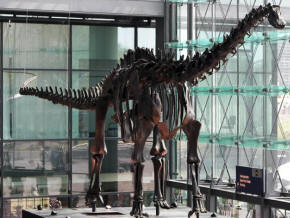|
Posture
The depiction of
Diplodocus posture has
changed considerably over the years. For instance, a classic 1910
reconstruction by Oliver P. Hay depicts two
Diplodocus with splayed lizard-like limbs on the
banks of a river. Hay argued that Diplodocus
had a sprawling, lizard-like gait with widely splayed legs, and was
supported by
Gustav Tornier.
However, this hypothesis was contested by W. J. Holland, who demonstrated
that a sprawling Diplodocus
would have needed a trench to pull its belly through. Finds of sauropod
footprints in the 1930s eventually put Hay's theory to rest.
Later, diplodocids were often
portrayed with their necks held high up in the air, allowing them to graze
from tall trees. Studies using computer models have shown that neutral
posture of the neck was horizontal, rather than vertical, and scientists
such as Kent Stephens have used this to argue that sauropods including
Diplodocus did not
raise their heads much above shoulder level. However, subsequent studies
demonstrated that all
tetrapods appear to
hold their necks at the maximum possible vertical extension when in a
normal, alert posture, and argued that the same would hold true for
sauropods barring any unknown, unique characteristics that set the soft
tissue anatomy of their necks apart from other animals. One of the sauropod
models in this study was Diplodocus,
which they found would have held its neck at about a 45 degree angle with
the head pointed downwards in a resting posture.
As with the related genus
Barosaurus, the very long
neck of Diplodocus
is the source of much controversy among scientists. A 1992 Columbia
University study of Diplodocid neck structure indicated that the longest
necks would have required a 1.6 ton heart — a tenth of the animal's body
weight. The study proposed that animals like these would have had
rudimentary auxiliary 'hearts' in their necks, whose only purpose was to
pump blood up to the next 'heart'.
While the long neck has
traditionally been interpreted as a feeding adaptation, a recent study
suggests that the oversized neck of Diplodocus
and its relatives may have been primarily a sexual display, with any other
feeding benefits coming second.
Diet
Diplodocus
has highly unusual teeth compared to other sauropods. The crowns are long
 |
| The original D. carnegii (foreground) at the Carnegie
Museum (Picture
Source) |
and slender, elliptical in cross-section, while the apex forms a blunt
triangular point. The most prominent wear facet is on the apex, though
unlike all other wear patterns observed within sauropods,
Diplodocus wear patterns
are on the labial (cheek) side of both the upper and lower teeth. What this
means is Diplodocus
and other diplodocids had a radically different feeding mechanism than other
sauropods. Unilateral branch-stripping is the most likely feeding behavior
of Diplodocus, as
it explains the unusual wear patterns of the teeth (coming from tooth-food
contact). In unilateral branch stripping, one tooth row would have been used
to strip foliage from the stem, while the other would act as a guide and
stabilizer. With the elongated preorbital (in front of the eyes) region of
the skull, longer portions of stems could be stripped in a single action.
Also the palinal (backwards) motion of the lower jaws could have contributed
two significant roles to feeding behaviour: 1) an increased gape, and 2)
allowed fine adjustments of the relative positions of the tooth rows,
creating a smooth stripping action.
With a laterally and dorsoventrally
flexible neck, and the possibility of using its tail and rearing up on its
hind limbs (tripodal ability), Diplodocus
would have had the ability to browse at many levels (low, medium, and high),
up to approximately 10 metres (33 ft) from the ground. The neck's range of
movement would have also allowed the head to graze below the level of the
body, leading some scientists to speculate on whether
Diplodocus grazed on
submerged water plants, from riverbanks. This concept of the feeding posture
is supported by the relative lengths of front and hind limbs. Furthermore,
its peglike teeth may have been used for eating soft water plants.
In 2010, Whitlock
et al. described a
juvenile skull of Diplodocus
(CM 11255) that differs greatly from adult skulls of the same genus: its
snout is not blunt, and the teeth are not confined to the front of the
snout. These differences suggest that adults and juveniles were feeding
differently. Such an ecological difference between adults and juveniles had
not been previously observed in sauropodomorphs.
Other
anatomical aspects
The head of
Diplodocus has been widely
depicted with the nostrils on top due to the
 |
| a) skull, b) classic rendering of the head with nostrils on top,
c) with speculative trunk, d) modern depiction with nostrils low on
the snout and a possible resonating chamber (Picture
Source) |
position of the nasal openings
at the apex of the skull. There has been speculation over whether such a
configuration meant that Diplodocus
may have had a trunk. A recent study surmised there was no
paleoneuroanatomical evidence for a trunk. It noted that the facial nerve in
an animal with a trunk, such as an elephant, is large as it innervates the
trunk. The evidence suggests that the facial nerve is very small in
Diplodocus. Studies by
Lawrence Witmer (2001) indicated that, while the nasal openings were high on
the head, the actual, fleshy nostrils were situated much lower down on the
snout.
Recent discoveries have suggested
that Diplodocus and
other diplodocids may have had narrow, pointed
keratinous spines
lining their back, much like those on an iguana. This radically different
look has been incorporated into recent reconstructions, notably
Walking with Dinosaurs. It
is unknown exactly how many diplodocids had this trait, and whether it was
present in other sauropods.
Reproduction and growth
While there is no evidence for
Diplodocus nesting
habits, other sauropods such as the
titanosaurian
Saltasaurus have been associated with
nesting sites. The titanosaurian nesting sites
indicate that may have laid their eggs communally over a large area in many
shallow pits, each covered with vegetation. It is possible that
Diplodocus may have done
the same. The documentary Walking with
Dinosaurs portrayed a mother
Diplodocus using an
ovipositor to lay eggs, but it was pure
speculation on the part of the documentary.
Following a number of bone
histology studies,
Diplodocus, along with
other sauropods, grew at a very fast rate, reaching sexual maturity at just
over a decade, though continuing to grow throughout their lives.
Previous thinking held that sauropods would keep growing slowly throughout
their lifetime, taking decades to reach maturity.
Classification
Diplodocus
is both the type genus of, and gives its name to
Diplodocidae, the family
to which it belongs. Members of this family,
while still massive, are of a markedly more slender build when compared with
other sauropods, such as the titanosaurs and brachiosaurs. All are
characterised by long necks and tails and a horizontal posture, with
forelimbs shorter than hindlimbs. Diplodocids flourished in the Late
Jurassic of North America and possibly Africa
and appear to have been replaced ecologically by titanosaurs during the
Cretaceous.
In popular
culture
Diplodocus
has been a famous and much-depicted dinosaur as it has been on display in
more places than any other sauropod dinosaur.
Much of this has probably been due to its wealth of skeletal remains and
former status as the longest dinosaur. However, the donation of many mounted
skeletal casts by industrialist
Andrew Carnegie to potentates around the
world at the beginning of the twentieth century
did much to familiarize it to people worldwide. Casts of
Diplodocus skeletons are
still displayed in many museums worldwide, including an unusual
D. hayi in the
Houston Museum of Natural Science,
and D. carnegii in
a number of institutions.
Diplodocus
has been a frequent subject in dinosaur films, both factual and fictional.
It was featured in the second episode of the award-winning BBC television
series
Walking with Dinosaurs.
The episode "Time of the Titans" follows the life of a simulated
Diplodocus 152 million
years ago. In literature,
James A. Michener's
book
Centennial has a
chapter devoted to Diplodocus,
narrating the life and death of one individual.
Diplodocus
is a commonly seen figure in dinosaur
toy
and
scale model lines. It
has had two figures in the Carnegie Collection.
Return to the
Old Earth Ministries Online Dinosaur
Curriculum homepage.

Shopping
Bay
State Replicas - None
Black
Hills Institute - None
|


